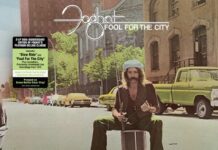Often misunderstood, wildly ambitious, a grand gesture and sweeping pinnacle in any artist’s discography, the double album — and we’re talking studio, not live — typically comes in two flavors: conceptual or a little bit of this, that and everything else. Either way, they are mighty undertakings that many of the greats have tackled. The Who, Pink Floyd, Yes and Genesis used four sides of vinyl to tell stories (of sorts); Bob Dylan’s Blonde On Blonde, Jimi Hendrix’s Electric Ladyland, the Rolling Stones’ Exile On Main Street and the Beatles’ White Album were more about variety. Led Zeppelin’s Physical Graffiti falls more in line with the latter — exemplifying the foursome’s diverse grasp of blues, folk, World, boogie woogie and hard rock in one full swoop. Most importantly, four decades after its release, Physical Graffiti still sounds fresh, convoluted and blooming with a unique sound and inspiration that made Led Zeppelin one of the biggest and baddest bands of the 20th century.
Following in the footsteps of the 2014 Led Zeppelin reissue campaign, Jimmy Page remastered Physical Graffiti to 21st century specs and threw in an extra disc filled with previously unreleased outtakes to rouse the completists and diehards. Unlike the five Zep remasters already served, the brightness in the mix of the 15 original tracks is significant and the bonus tracks enlightening. An early mix of “Trampled Underfoot” with the working title “Brandy & Coke” offers an echoey double-tracked vocal from Robert Plant and extended clavinet solo from John Paul Jones that adds a distorted edge to one of the band’s funkiest songs. An instrumental mix of “Sick Again” only proves how infectious the song’s main riff is.
The coup d’état is “Everyone Make It Through,” an early version of “In The Light,” which to this critic, remains one of Zeppelin’s most underrated magical moments. Here, in its development, it’s rather hippy-dippy before morphing into the epic tune it became. Indeed, Led Zeppelin mastered the modern sheen, without succumbing to the golden age’s time-affected gimmicks. This is why ensuing generations are hard-pressed to put Led Zeppelin in a time capsule.
As for the album itself, it got off to a slow and unsteady start. John Paul Jones came close to leaving the band to become the organist for the Winchester Cathedral. John Bonham was weary from the road, drinking more, weighing more, yet playing as well as ever. Page and Plant continued to mine the well for new musical ideas. It didn’t come easy. To fill out the album, songs like “Houses Of The Holy,” the unreleased title track from the previous album recorded in 1972, were revisited and added to the pile. The band also threw in impromptu jams like “Boogie With Stu,” recorded with the Rolling Stones pianist Ian Stewart, and mellower, whimsical tracks like “Ten Years Gone” and “Down By The Seaside” to the mix.
Two weeks after Physical Graffiti hit the streets, I saw Led Zeppelin at the Long Beach Arena for a three-hour roller coaster of rarefied rock and roll. I’d already procured a copy of the new album, absorbing thunderous raptures like “Custard Pie,” “In My Time Of Dying” and “Kashmir” (the second disc didn’t initially register as powerfully as the first, but I’ve found during subsequent playbacks that I routinely reach for it first). At the time, I had no idea I was seeing arguably the last great tour from one of the last great bands of the classic rock era. Hearing Physical Graffiti now has brought it all back — life-altering sounds, the mid 70s, a pivotal period that was about to give way to more tumultuous days ahead. Come on baby, just rock, rock, rock.
~ Shawn Perry




















